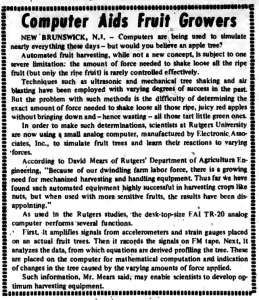Nov. 22, 1967: Analog computer simulations shake up agriculture
Tree shaking was an early attempt to automate crop harvesting. Analog computers, now obsolete, were used to refine the process.

Many of the most successful real-world applications of automation technology have occurred within the agricultural sector. Innovations combining artificial intelligence and robotics have achieved unprecedented levels of efficiency and environmental sustainability in agricultural tasks such as irrigation, herbicide application, and crop harvesting. A USDA survey conducted in 2018 found that the majority of corn – America’s most widely produced crop – was planted using automation technology. The widespread adoption of automation in agriculture has been driven not only by the success of the technology, but also out of necessity – with a dwindling farm labor force, automation has become critical to optimizing crop yields and meeting the demands of a growing population.
Modern automated harvesting technology relies on sophisticated computer vision systems and robotic grasping tools to precisely locate and pick ripe produce. In comparison, early approaches to automated harvesting were quite rudimentary, employing mechanical methods such as forcefully shaking trees to loosen their fruit. The tree shaking method caused damage to most produce, limiting its success to hard-to-damage crops like nuts. It was also imprecise, unintentionally harvesting and wasting unripe fruit.
In 1967, an article in Computerworld magazine highlighted how analog computer simulations could improve the precision of the tree shaking method. A research team at Rutgers University had used a 100-pound analog desktop computer called the EAI TR-20 to record data from sensors placed on fruit trees and model how applying varying amounts of force affected fruit trees. The researchers hoped the insights gained from their models could optimize the tree-shaking method to reduce the amount of unripe fruit wasted.
Though now obsolete, analog computers were once commonplace in laboratories and were important to many technological milestones, including early space travel. Analog computers represent data using continuous voltages or currents, while digital computers use discrete zeros and ones. The superior computational speed and accuracy of digital computers made analog computers obsolete after the 1960s.
Over 50 years later, mechanical tree shakers are still used to harvest nuts. Research to optimize tree shaking has evolved to include cutting-edge techniques in artificial intelligence. In a 2017 study from Washington State University, researchers trained a computer vision algorithm to detect the location of branches on a cherry tree and identify where to shake on the branch to maximize the number of fallen cherries. The algorithm was successful, resulting in over 90% of the cherries falling.
–By Kathleen Esfahany